Image to Prompt AI: Transform Your Images into Creative Text Prompts
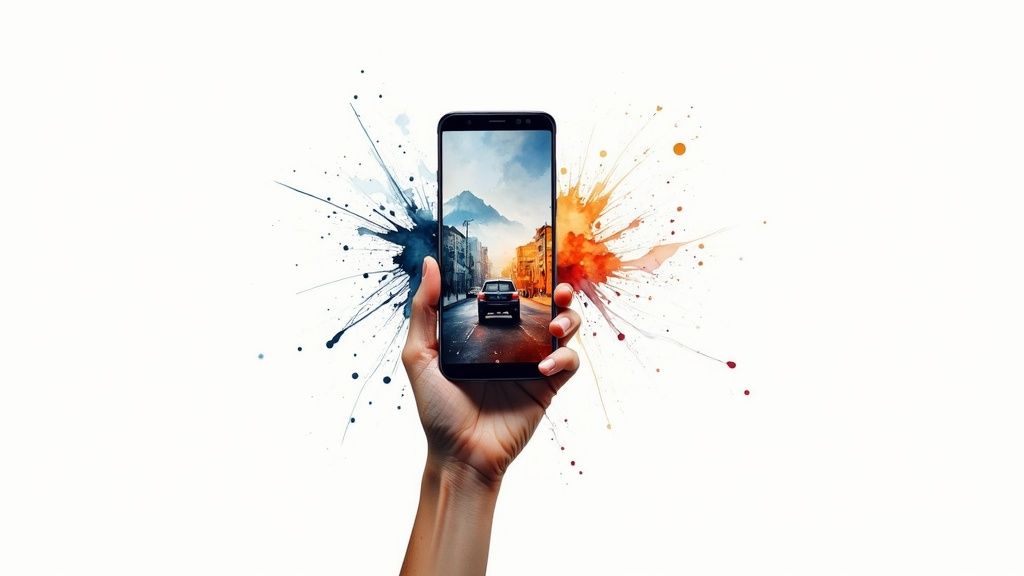
Have you ever stumbled upon a stunning AI-generated image and just wondered, "How on earth did they come up with the prompt for that?" You're definitely not the only one. Think of an image to prompt AI as your personal art decoder. It can look at any image and translate its style, mood, and subject matter into the exact kind of text prompt that AI art generators can understand.
The Power of Decoding Digital Art
Imagine you find a piece of digital art that perfectly nails the aesthetic you're going for in a project. Instead of spending the next few hours trying to put that vibe into words, you could just use a tool to break down its core elements and spit out a prompt you can use immediately. This is the practical magic of reverse prompting. It’s a complete game-changer for anyone working with AI art, from seasoned designers and marketers to hobbyists just playing around.
This whole process is a lot more than just a simple description, though. These tools really deconstruct an image into its fundamental pieces:
- Subject and Composition: It figures out the main focus of the image and how everything is arranged.
- Artistic Style: The tool can recognize if the image is going for a photorealistic look, an anime style, something impressionistic, or a thousand other styles.
- Mood and Lighting: It's great at capturing the overall atmosphere, picking up on things like "cinematic lighting" or a "soft, ambient glow."
- Technical Details: Some tools can even suggest specific camera angles, lens types, or even name the artists whose styles might have influenced the final look.
Why This Skill Matters
Getting the hang of using an image to prompt AI isn't just a neat party trick; it's a massive creative shortcut. It lets you build on existing inspiration instead of staring at a blank canvas, trying to will an idea into existence. This kind of efficiency is what’s fueling some serious industry growth. The global AI image generator market was valued at 299.3 million in 2023** and is expected to rocket to **917.4 million by 2030.
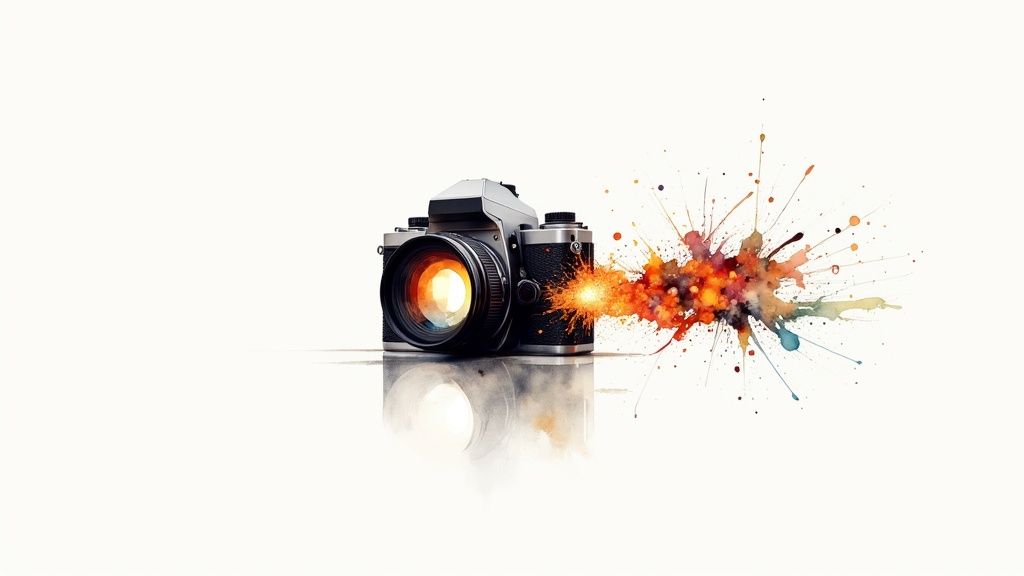
By translating visual concepts into structured text, you bridge the gap between inspiration and creation. You stop guessing what works and start engineering prompts with precision, saving time and producing more consistent, high-quality results.
For a really solid deep dive into the entire process, from deconstructing visuals to generating those detailed prompts, check out A Creator's Guide to Image to Prompt AI. Mastering this skill gives you the power to turn any visual you admire into a concrete starting point for your own unique work.
Finding the Right Reverse Prompting Tool for You
Alright, the first real step in turning that visual spark into a workable prompt is picking your tool. The world of image to prompt AI tools isn't a one-size-fits-all situation, so finding the right fit really comes down to your personal workflow, how tech-savvy you feel, and what you're trying to achieve.
Your choice here directly shapes how fast you can work, the level of detail you get back in your prompts, and just the overall feel of the process.
The most straightforward options out there are browser-based websites. These are perfect when you just need a quick analysis of an image. You just upload your file, and a few seconds later, you get a text prompt. No installation, no fuss—it’s the ideal starting point for beginners who want results right away.
Tool Types at a Glance
If you practically live on Discord, then a specialized bot is probably your best bet. These tools integrate right into your Midjourney or Stable Diffusion server, letting you reverse-engineer a prompt without ever needing to switch windows. For anyone who generates images frequently, this kind of seamless workflow is a huge time-saver.
Then there’s the path for those who want total control and privacy: local installations. Running a model like a CLIP Interrogator directly on your own computer means your images never leave your hard drive. This approach definitely requires more technical know-how to set up, but it offers unmatched customization and the ability to work completely offline. If you're building a serious creative toolkit, it’s worth exploring various AI image tools for visual content creation to see what’s possible.
To help you decide, here’s a quick breakdown of the different tool types and who they're best for. Think of it as a guide to matching the tech to your specific needs.
Comparing Image-to-Prompt AI Tools
| Tool Type | Best For | Pros | Cons |
|---|---|---|---|
| Web-Based Tools | Beginners and quick, one-off tasks | Easy to use, no setup required, fast results. | Less control, potential privacy concerns, may have usage limits. |
| Discord Bots | Frequent Midjourney or Stable Diffusion users | Seamless integration into existing workflows, very convenient. | Requires being on Discord, functionality can be limited to the bot's design. |
| Local Installations | Advanced users and privacy-conscious creators | Maximum control, total privacy, works offline. | Requires technical setup, needs a powerful computer, steeper learning curve. |
Ultimately, the goal is to find the tool that best fits into how you work. Each option gets you to the same place—a text prompt from an image—but the journey there can be very different.
Remember, the best tool is the one that removes friction from your creative process. Whether it’s a simple web uploader or a complex local setup, its job is to help you translate your visual ideas into text as efficiently as possible.
It's also worth noting that many modern AI models are starting to build this capability right in. You can get a better sense of how different AIs handle this in our comprehensive overview of Google Gemini's features and its impact on creative workflows.
A Practical Walkthrough of Your First Prompt Extraction
Alright, enough with the theory. The best way to get a feel for this is to actually do it. Let's take a complex image and run it through an image to prompt AI tool to see what we get. The real goal here isn't just to copy-paste the output, but to learn how to read it, tweak it, and ultimately make it your own.
For this little experiment, I’m grabbing a classic subject: a moody, rain-soaked city street at night. An image like this is packed with detail—reflections bouncing off wet pavement, specific kinds of light, and a heavy atmosphere. It's the perfect stress test for any reverse prompting tool.
Uploading and Analyzing the Initial Output
First things first, you need to get the image into a tool. Most web-based options, like the popular CLIP Interrogator, have a simple drag-and-drop interface. You just upload your file and give the AI a moment to do its thing.
This whole process is usually a simple, three-stage affair, as you can see below.
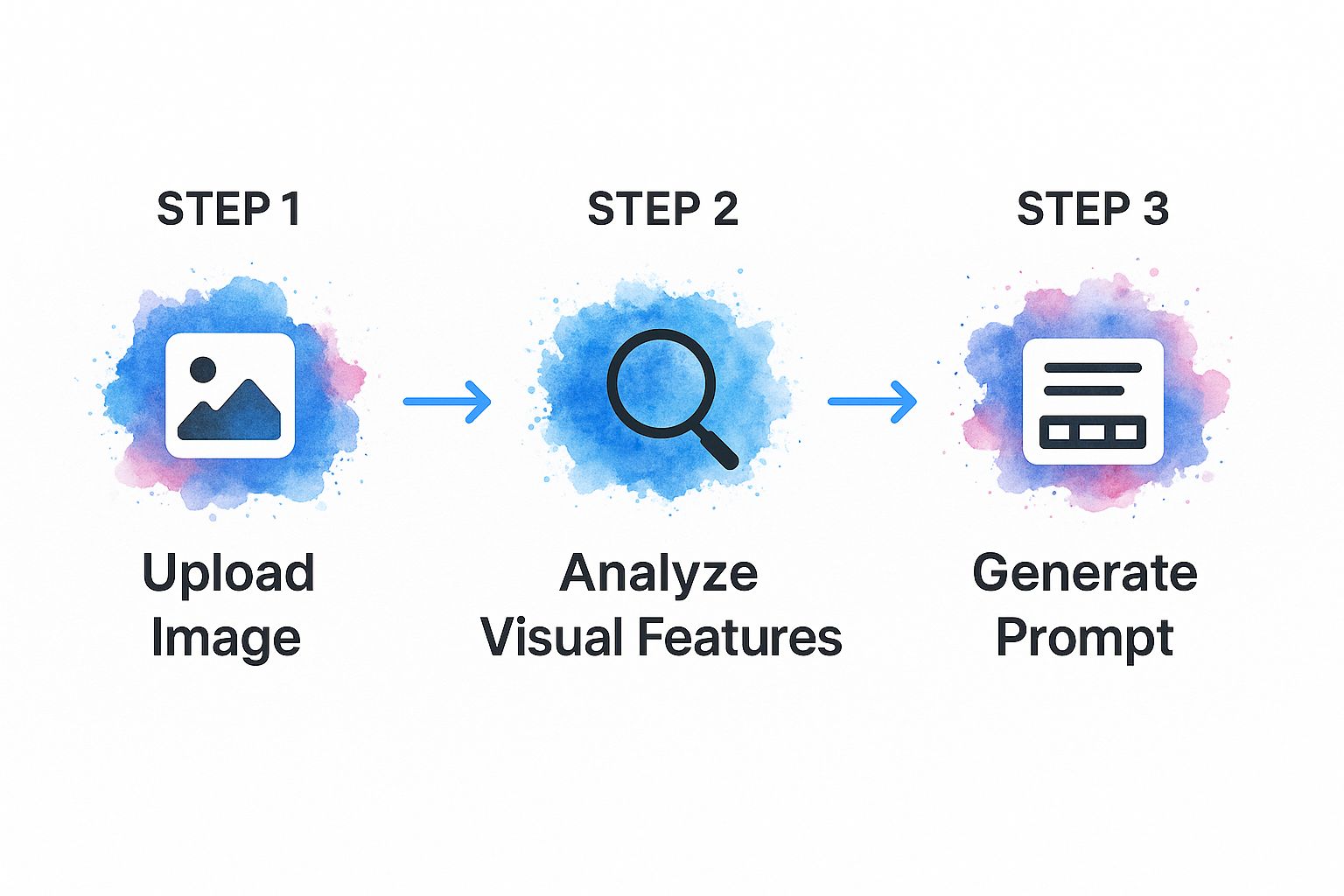
It’s pretty straightforward: you provide the image, the AI breaks it down, and you get a text prompt back.
After a few seconds, the tool spits out a raw string of text. Think of this as your raw material. It's often a jumbled mess of keywords, artist names, and technical jargon—not a finished, elegant prompt.
From Raw Data to a Polished Prompt
This is where your job really starts. The AI’s first draft is rarely perfect; it might be clunky, repetitive, or full of stuff you don't need. You have to step in and act as an editor, pulling out the parts that truly matter.
For our rainy city photo, the raw output might identify key elements like "city street at night," "wet pavement," and "neon lights," but it’ll probably throw in some less helpful terms, too.
From this point, your focus should be on restructuring the prompt for whatever AI model you're using, whether it's Midjourney or Stable Diffusion. Hone in on the core components that create the image's aesthetic.
- Cut the Jargon: Get rid of generic terms or weird tags that add no real value.
- Prioritize What Matters: Pull the most descriptive words ("cinematic lighting," "glowing neon," "rain-slicked asphalt") to the front of the prompt.
- Add Your Own Spin: This is your chance to inject your own style. Maybe you want to push it toward a "cyberpunk aesthetic" or lean into a "film noir mood" to give the AI clearer direction.
This refinement process is what separates decent images from incredible ones. And the demand for these skills is exploding. Market research projects the AI image generator market will skyrocket from 8.7 billion in 2024 to an incredible 60.8 billion by 2030. That’s a clear sign of how fast this field is growing.
The best prompts are a collaboration between human creativity and AI analysis. The tool provides the building blocks; you provide the artistic direction.
By learning to interpret and edit the AI's output, you turn a simple description into a powerful creative command. If you’re ever stuck for ideas, browsing through a big collection of image prompts for various AI models is a great way to see how other people structure their requests. It’s the key to turning a piece of visual inspiration into a solid starting point for your next creation.
How to Refine Prompts for Superior AI Art
Getting a basic prompt from an image to prompt ai tool is a fantastic starting point, but it's rarely the finish line. Think of that raw output as a block of marble. It’s on you, the sculptor, to chip away the unnecessary bits and polish the details to reveal the masterpiece inside.
This is where you stop being a user and start being a creator, turning a generic description into a powerful, intentional brief for the AI.
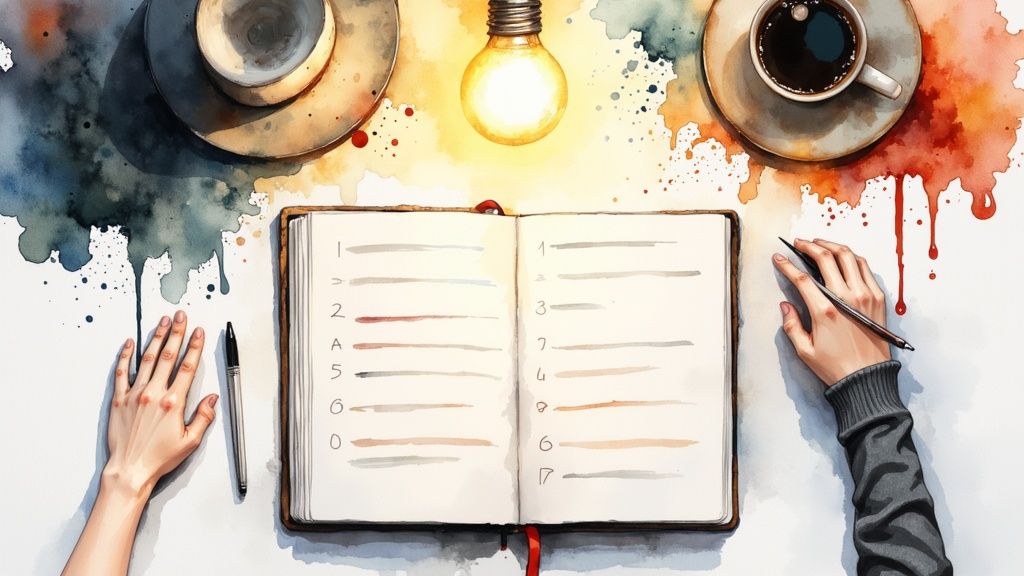
Often, the first move is subtraction. An AI might throw a dozen keywords at you, but many will be redundant or even conflicting. Your first job is to cut through the noise and zero in on the terms that truly capture the image's core aesthetic.
Injecting Specific Artistic Direction
Once you have a cleaner base, it's time to add your own artistic touch. This is your chance to inject the specific details the AI might have missed or couldn't quite articulate. Ask yourself: what makes this image special? Then, translate that feeling into specific, actionable commands.
A generic prompt might give you "city at night." A refined prompt looks more like this: "cinematic lighting, glowing neon reflections on wet asphalt, shot on Portra 400 film."
See the difference? These details give the AI much clearer instructions, leading to a richer, more intentional final image. It's no surprise that this level of control is becoming second nature for many creators. A recent survey even found that 58% of respondents are already using AI in their photo editing workflows, mostly to save time. You can explore the latest AI image statistics to see just how widespread this has become.
The gap between a good AI image and a great one often comes down to a few well-chosen keywords. Adding terms like "hyperrealistic detail," "octane render," or "soft, volumetric lighting" can dramatically elevate the quality of your output.
Using Negative Prompts and Keyword Weighting
Another incredibly powerful technique is telling the AI what you don't want. This is where negative prompts come in. If your generations consistently turn out with blurry backgrounds or distorted hands, you can add a command like --no blurry background, malformed hands. This simple trick helps steer the AI away from common pitfalls and keeps your results clean.
You can also get more granular by adjusting keyword weights, which tells the AI which parts of your prompt are most important.
In a tool like Midjourney, you can do this by adding :: followed by a number to a word (e.g., futuristic city::2 cyberpunk::1). This command tells the model that "futuristic city" is twice as important as "cyberpunk," giving you more direct control over the final composition.
To really get into the weeds with these kinds of advanced techniques, be sure to check out our guide on mastering AI prompt engineering tips and tricks.
Common Mistakes to Avoid in Reverse Prompting
Learning what not to do when turning an image into a prompt can save you hours of headaches. I've been there. The biggest trap you can fall into is blindly trusting the AI's first shot at a prompt. Think of that raw text as a rough draft, not the finished product. Using it as-is almost always leads to cluttered or generic images.
Another easy mistake is creating prompts that are way too long or, even worse, contradictory. It's tempting to cram every single detail you see into the text box, but an overly wordy prompt just confuses the AI. For instance, throwing "minimalist" and "highly detailed" into the same prompt is a recipe for a muddled, nonsensical picture.
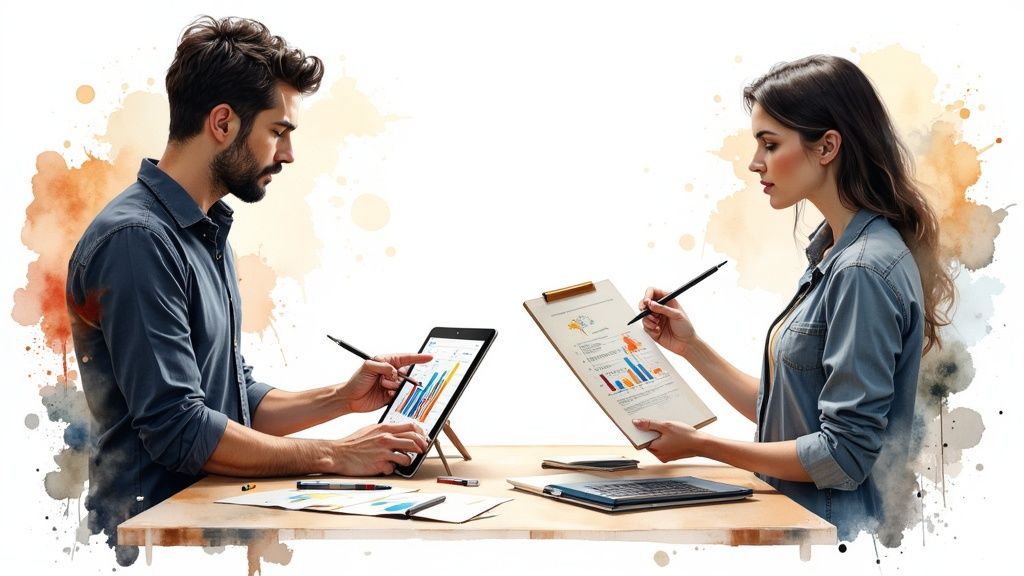
Cross-Platform Prompt Compatibility
Here's something a lot of people learn the hard way: a brilliant prompt is rarely universal. A string of words that coaxes a masterpiece out of Midjourney might completely fall flat in Stable Diffusion without some tweaking. Each model has its own personality and speaks a slightly different language.
- Midjourney: Tends to love natural, conversational language and atmospheric, artistic descriptions.
- Stable Diffusion: Often performs better with more technical, comma-separated keywords. It also responds well to specific terms like artist names or rendering engines.
The best way to think about it is this: the initial image to prompt AI output gives you a pile of ingredients. Your job is to pick the best ones and arrange them into a recipe that your chosen AI model will actually understand and execute beautifully.
Once you start sidestepping these common blunders, you'll find your confidence and your workflow improve dramatically.
Common Questions About Image To Prompt AI
If you're just dipping your toes into turning images into prompts, you probably have a few questions. It's a seriously powerful technique, but wrapping your head around the details is what separates a decent result from a great one. Let's tackle some of the most common things people ask.
Does This Work for Any Art Style?
Pretty much, yeah. An image-to-prompt tool can digest a huge variety of styles—everything from photorealistic renders and classic anime to pure abstract art. It's trained to spot the core ingredients like color palettes, line weight, and overall composition, then break them down into descriptive keywords.
That said, the accuracy can vary. Its performance really hinges on the tool's training data and how complex your source image is.
Is Reverse Prompting the Same as Plagiarism?
This is a big one. It's best to think of this as a learning and inspiration tool, not a copy-and-paste machine. The prompt it spits out is just a launchpad. Your real creative work comes from twisting, refining, and combining those ideas to build something totally new.
The whole point is to deconstruct a style you admire so you can learn from it, not to perfectly replicate the original piece. Always stay mindful of copyright if you're using source images you don't personally own.
Ultimately, it’s about understanding the "how" behind a visual that catches your eye.
Why Do I See Artist Names in My Prompts?
Good question. These AI models are trained on absolutely massive datasets of art, and a lot of that art is tagged with the artists' names. When a tool sees a style that closely matches an artist in its database, it suggests their name (like "by Greg Rutkowski") as a quick shorthand for that specific look and feel.
You can definitely keep those names if you like the aesthetic they produce, or just as easily remove them to give the AI a bit more creative freedom.
Ready to turn that spark of inspiration into a finished creation? Jump over to PromptDen and explore thousands of high-quality prompts and tools. Find your next great idea at https://promptden.com.